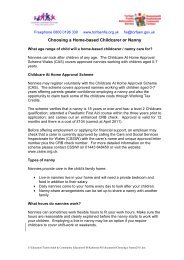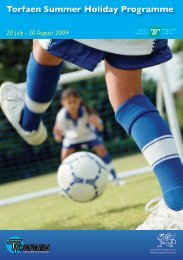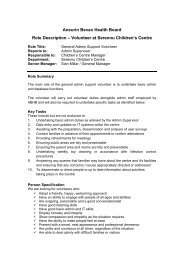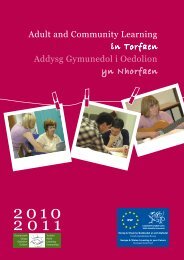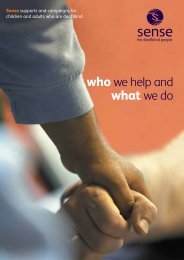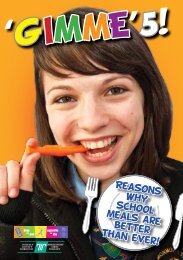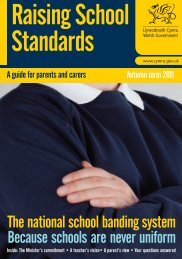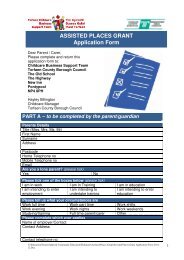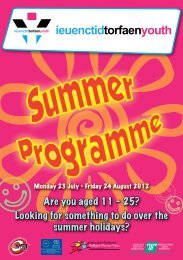Food and Health Guidelines - Torfaen Family Information Service
Food and Health Guidelines - Torfaen Family Information Service
Food and Health Guidelines - Torfaen Family Information Service
Create successful ePaper yourself
Turn your PDF publications into a flip-book with our unique Google optimized e-Paper software.
6. Menu Planning<br />
Vegan diets<br />
Vegans do not eat any foods of animal<br />
origin. This includes meat, fish <strong>and</strong> dairy<br />
foods, <strong>and</strong> also honey. Vegan diets may be<br />
low in a number of nutrients such as energy,<br />
protein, vitamins B2 <strong>and</strong> B12, calcium, zinc<br />
<strong>and</strong> iron.<br />
These diets need careful planning <strong>and</strong><br />
vitamin supplements may be necessary to<br />
complement the menu. The Vegan Society<br />
recommends that vegans take supplements<br />
of Vitamin B12, Vitamin D <strong>and</strong> calcium.<br />
When cooking food for vegetarians/<br />
vegans, who exclude food items for<br />
religious or ethical reasons, it is important<br />
that food given is not compromised in any<br />
way. For example, picking meat out of a<br />
dish already cooked is not appropriate.<br />
The vegetarian/vegan dish should be<br />
prepared first <strong>and</strong> the meat added later for<br />
other children.<br />
Work in partnership with parents/carers/<br />
dietitian to devise a suitable menu for the<br />
child including foods the child is familiar with<br />
at home, <strong>and</strong> which particular foods are to<br />
be avoided e.g. gelatine <strong>and</strong> rennet.<br />
<strong>Food</strong> customs of different<br />
cultures<br />
Some groups in the community may have<br />
different food customs from those of<br />
your staff. The food customs may involve<br />
what foods are eaten, how the foods are<br />
prepared, what combinations of foods are<br />
used or when particular foods are eaten.<br />
Also periods of celebration <strong>and</strong> celebration<br />
foods may bring new events to the Early<br />
Years setting. It is important not to make<br />
assumptions about what a child eats<br />
from their name, religion or appearance.<br />
Always ask for specific information<br />
from parents. See Appendix 5 for more<br />
information.<br />
Adapting Menus<br />
In many cases, dishes that are provided for children with special dietary requirements are<br />
suitable for all children. This is especially the case with vegetarian dishes <strong>and</strong> cultural<br />
variations. However, where an alternative is provided, e.g. in milk-free diets, it is really<br />
important to ensure that the alternative looks similar to the regular choice.<br />
Children from an early age want to feel part of the group <strong>and</strong> not be excluded.<br />
For example, using soya milk for custard or white sauce can enable the child on a milkfree<br />
diet to enjoy custard or fish pie alongside other children. It may be possible to make<br />
up a batch of the alternative food <strong>and</strong> freeze individual portions to save time later on.<br />
It is also important that whatever foods need to be excluded they are replaced with a<br />
food from the same group wherever possible so the nutritional content of the meal is<br />
not affected.<br />
Some settings highlight a child with an allergy by using a different coloured plate or<br />
specially marked placement. Whilst this could potentially cause the child to feel different,<br />
the settings have not seen this to be the case, <strong>and</strong> it means that all staff are aware of the<br />
allergy whichever room they work in.<br />
17




